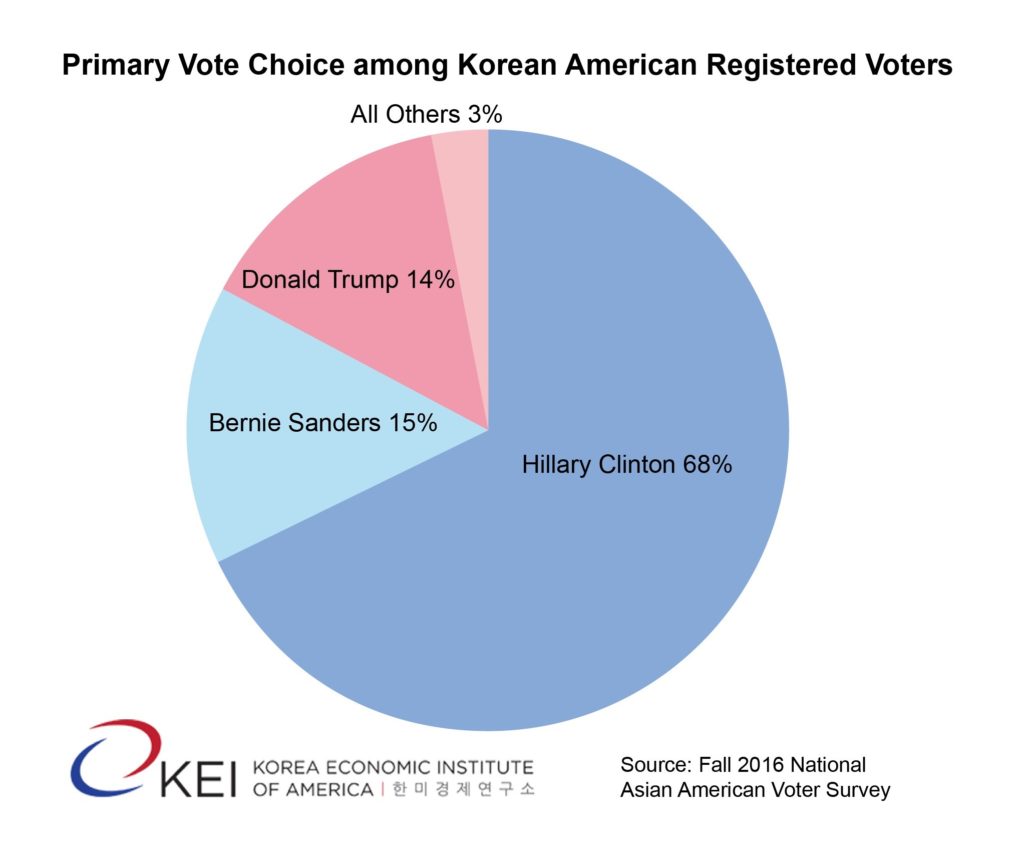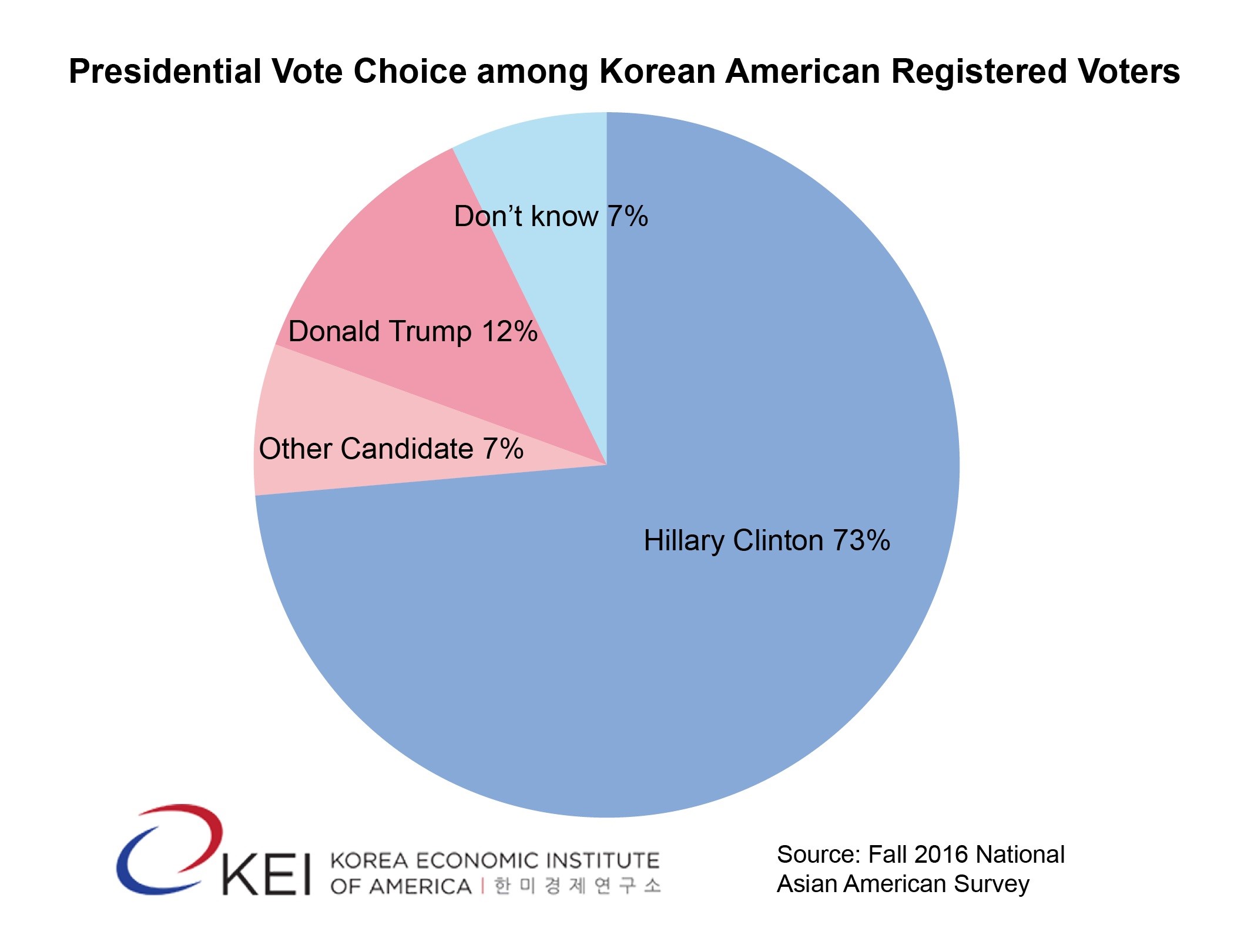The Peninsula
The Korean-American Vote: Update on the 2016 Presidential Election

By Junil Kim
Earlier this year, we examined Korean-American voting preferences and the importance of the Korean-American vote in the years to come. A May 2016 survey conducted by three Asian American NGOs showed a significant preference by Korean-Americans for the Democratic Party and its presidential nominee, Hillary Clinton. However, the survey also showed that Clinton only garnered 29 percent of the intended primary vote among Korean-Americans. Now, the newly released Fall 2016 National Asian American Survey (NAAS) shows that Clinton has strengthened her support among Korean-American voters since the previous survey.
The May survey, which consisted of telephone interviews with 1,212 registered voters from April 11 to May 17, 2016, reported that 60 percent of Korean-American voters had a favorable view of Hillary Clinton, with 37 percent holding an unfavorable view of the presidential candidate. The NAAS, which interviewed 1,955 registered voters from August 10 to September 29, 2016, showed that Korean-American voters largely maintained their views of the Democratic nominee, with 58 percent of Korean-American voters indicating they had a favorable view of Clinton and 41 percent indicating an unfavorable view. The overall 3.5 percent margin of error of the NAAS and the 3 percent margin of error of the earlier survey shows that the favorability ratings have essentially remained unchanged since this spring.
Korean-American voters also generally retained their unfavorable views of Donald Trump. The May survey indicated that 80 percent of Korean-American voters held an unfavorable view of the Republican nominee and only 10 percent of voters held a favorable view. The NAAS shows a slight uptick in both ratings, with 84 percent of Korean-American voters holding an unfavorable view and 12 percent holding a favorable view.
The primary vote choice results reported in the NAAS suggest that Clinton has taken advantage of her favorable ratings among Korean-American voters since this spring. The earlier survey, which occurred in the latter half of the primary season, reported that 29 percent of Korean-American voters had voted or planned on voting for Hillary Clinton in state primaries. Democratic candidate Bernie Sanders garnered 20 percent of the expected primary vote, Republican candidate Ted Cruz held 12 percent, and Donald Trump held 7 percent of the Korean-American vote. In addition, 32 percent of Korean-American voters also indicated they had voted or would vote for “someone else.” The NAAS, which occurred after both Clinton and Trump secured their respective party’s nomination, reported that Clinton actually garnered a much larger share of the Korean-American vote with 68 percent of voters saying they cast ballots for Clinton during the primaries.
Clinton’s sizable increase in her voting share among Korean-Americans raises questions about how she secured greater support. Although some initial Sanders supporters may have switched to Clinton, this does not completely account for the substantial difference in support from the earlier survey results. The likely primary source is from the 32 percent of Korean-American voters in May that reported their primary candidate choice was “someone else.” The option “someone else” likely indicated undecided or uncertain voters, and Clinton’s strong showing in the primary results may be due to the consolidation of these voters.
This gravitation by Korean-American voters to Clinton is also clear in their reported presidential vote choice. Clinton currently eclipses Trump by a massive 61 points among Korean-American voters, which shows a slight uptick in Clinton support among Korean-Americans compared to the primary results. Compared to Americans in general, Korean-American support for Clinton and Trump dramatically differs. In the latest four way RealClearPolitics polling average, Clinton’s holds 44 percent of the general vote and Trump holds nearly 40 percent.
As mentioned in our earlier blog, Korean-American voters and Asian-American voters in general are unlikely to swing the upcoming presidential election, but the rapid population growth of Korean-Americans in swing states like Florida, Nevada, and Virginia will make their vote increasingly important to political candidates. Although the latest survey results show immense Korean-American support for Clinton, the majority of Korean-Americans in the last presidential election did not identify with the Democratic Party and Korean-Americans still self-identify more as conservative than liberal. In an analysis of the 2012 presidential election, Dr. Taeku Lee noted the steady shift of Korean-American voters towards Democratic candidates over the past 20 years and that the GOP would have to moderate their views on issues like health care and immigration to earn a larger share of the Korean-American vote. The 2016 presidential race has done little to break the trend of growing Democratic support among Korean-American and other Asian-American voters, and future Republican nominees would be prudent to consider the importance of their vote.
Juni Kim is the Program Manager and Executive Assistant at the Korea Economic Institute of America (KEI). The views expressed here are the author’s alone.
Photos from US Embassy New Zealand and Gage Skidmore on flickr Creative Commons.


